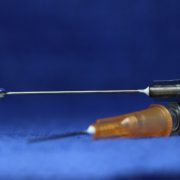Before you get a Cortisone Injection – Ask these questions
Cortisone (or steroid) injections have become increasingly popular over the years for people looking to address chronic joint pain and inflammation.
Why have they become so popular? Well, for starters, they have a reputation for getting rid of pain quickly, and they are generally considered a better alternative to something like surgery. But there can be consequences when you choose the “quick-fix” route. Before you decide on whether or not a cortisone injection is right for you – let’s look at some important considerations.
First… the benefits…
Quick Relief:
This is the main reason folks don’t think twice about getting a cortisone injection. And when you’ve been suffering for a while with something like back or knee pain – or it keeps coming back at the most inopportune times – cortisone injections are an attractive option.
Targeted Treatment:
In contrast to a pain pill – or even an oral steroid – people like the idea of a cortisone injection because you can choose exactly where it’s going to go. This makes your treatment more targeted and theoretically, more effective. Plus, a localized injection compared to an oral medication could mean smaller amounts of the drug going into your body, thus, potentially minimizing any potential side effects.
Alternative to Surgery:
I’m a huge advocate of avoiding surgery unless absolutely necessary. So if all other conservative and natural treatments have truly failed, then a cortisone injection could be a good option for you. It’s certainly better than a surgical procedure.
Now – let’s look at the risks and side effects…
Cartilage Damage and Weakening of Tendons:
Based on research and evidence, we know that repeated cortisone injections cause damage to cartilage (the cushioning material inside your joints) and weakening of tendons. This might not be an issue for you if you know you’re getting a joint replacement surgery and using cortisone to pass the time and help control pain. But otherwise, repeatedly getting cortisone injections in your joints or tendons will increase your likelihood of needing surgery down the road – so it’s an important consideration – especially if your first cortisone injection doesn’t work or doesn’t last.
Risk of Infection:
This is an important risk to consider – especially when it comes to cortisone injections in your spine. With any type of injection – you run the risk of inadvertently introducing bacteria, which could lead to serious complications. While an infection is not ideal in any area of your body, it can be especially dangerous in your spine because it could lead to things like meningitis and epidural abscesses.
Short-term Relief:
While the quick pain relief you can get from a cortisone injection seems attractive, there are unintended consequences. First, even though joint inflammation is what’s causing you pain, it’s rarely the root cause of your problem. That’s why the relief you get from cortisone injections rarely lasts and the pain returns. The problem with this is that you’re more likely to get repeat cortisone injections which we know causes damage. Plus, once the pain is gone, you think your problem is gone, and you’re less likely to address it.
If after all this you’re still considering a cortisone injection – at least ask these important questions first…
-
Are you absolutely sure the root cause of your issue is inflammation? Or is it a symptom of an underlying problem?
I can’t tell you how many people (even healthcare providers) get this wrong. Since 70-80% of all joint pain is mechanical in nature – meaning something in the joint isn’t moving right, and thus, irritating the surrounding structures which can lead to inflammation – it’s critical you rule this out first. Cortisone injections won’t fix an underlying mechanical problem.
-
What are the long-term side effects of repeated cortisone injections?
This can be a bit of a trick question – because we already know the answer to this. Repeated cortisone injections cause joint and tendon damage. If your doctor is not already aware of the current research, or dismisses it, they are less likely to caution you away from the procedure when there could be better, more natural alternatives. It’s always important to be well-informed and advocate for yourself when you’re working with any type of healthcare practitioner and being recommended an injection or procedure of any kind.
-
What are the alternatives?
Have you already tried quality physical therapy treatment that is designed to address your underlying problem and help you get rid of your joint inflammation naturally? Pain relief is slower with this option, and can sometimes be worse before it gets better, but it’s more likely to result in long-term relief instead of short-term. Movement and exercise are considered the best medicine when it comes to joint pain, inflammation, and arthritis. You may need some guidance so as not to overdo it, but exercises such as Pilates and Yoga are gentle on your joints, allowing you for safe movement without exacerbating your pain in most cases.
When prescribed properly, cortisone injections do work. But sadly, for most people, steroid injections are oversubscribed, not always necessary, and disappointing when they don’t work or last.
I’ve seen too many cases over the course of my career where cortisone injections provide a false sense of hope, or worse, irreversible joint damage. For all of these reasons, I highly recommend you educate yourself, and consider all the risks and possible alternatives before you get a cortisone injection. I’m a huge fan of avoiding pills, procedures, and surgery and using natural movement and exercise to get rid of most musculoskeletal problems. If you’re looking to do the same – consider talking to a mechanical pain expert who can help you.

Dr. Carrie Jose, Physical Therapist and Pilates expert, owns CJ Physical Therapy & Pilates in Portsmouth and writes for Seacoast Media Group. To get in touch, email her at [email protected].




